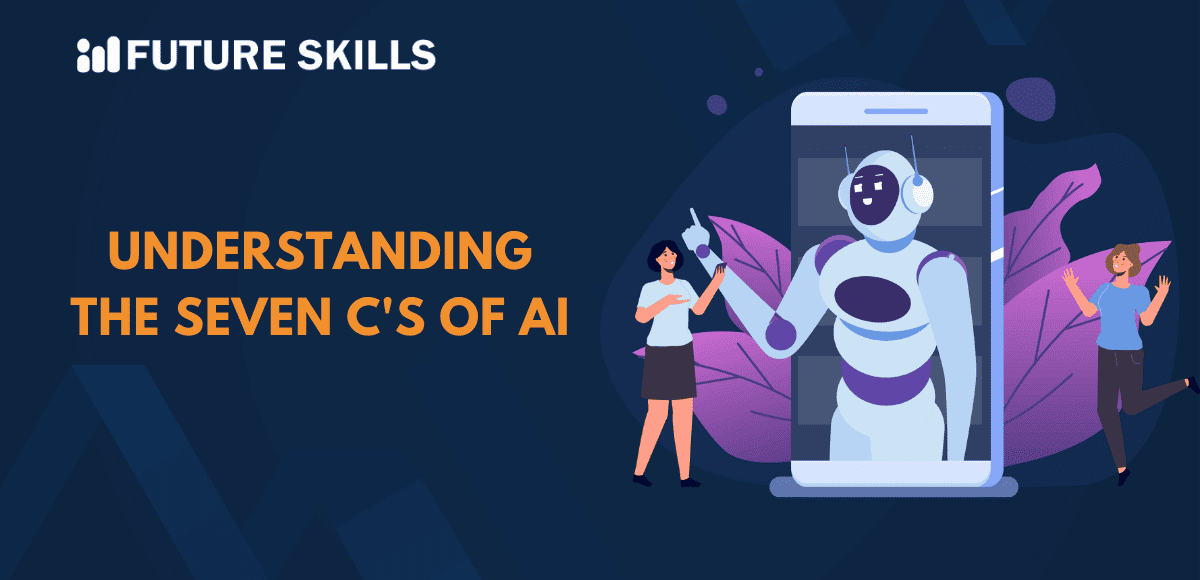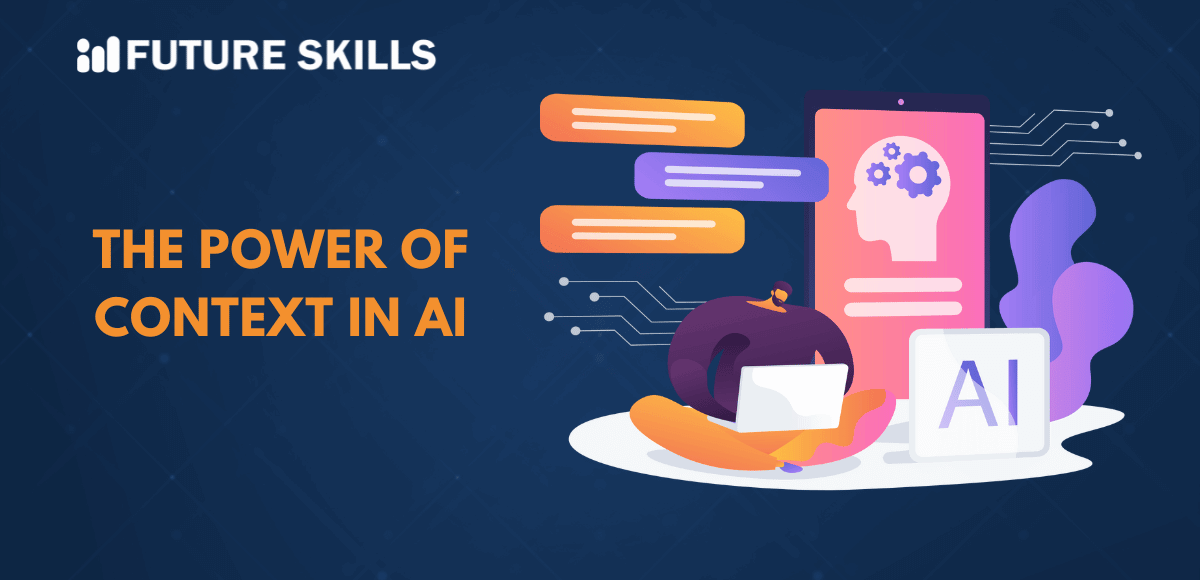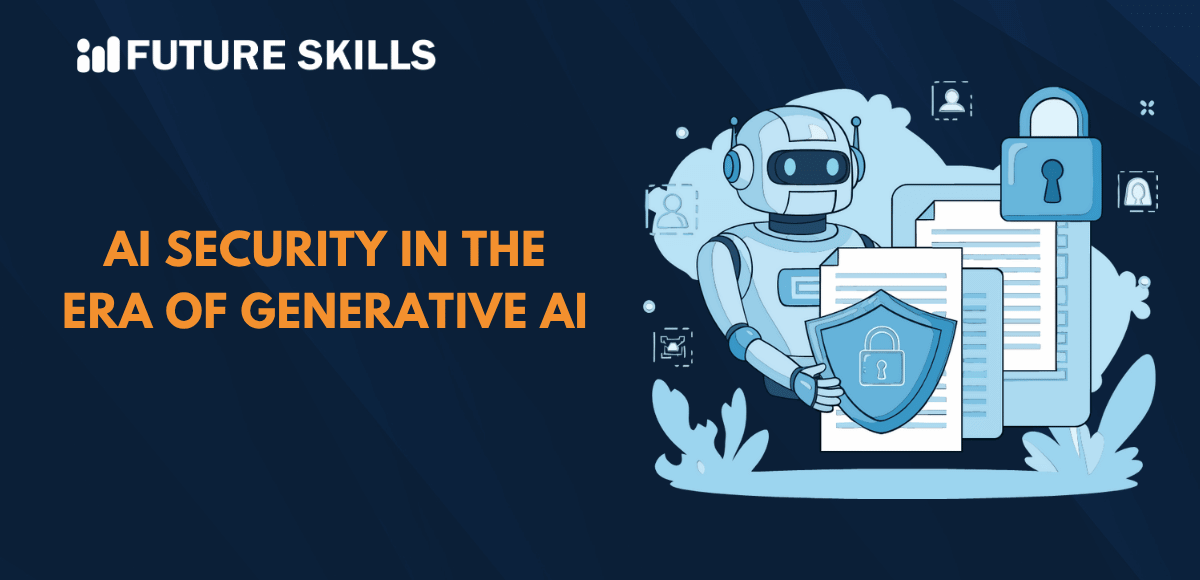Artificial Intelligence has emerged as one of the most popular technological innovations and is no longer just a futuristic concept. It has transformed how people interact with technology. It has become an integral part of our life shaping the way we interact with technology. From writing mail to self-driving cars, AI is transforming each industry at a rapid pace. However, with great power comes great responsibility. To understand the framework of AI and its complexity, one needs to know the seven C’s of AI. This serves as a guiding framework for understanding it well.
Understanding each of the elements of 7C of AI helps individuals and organizations to develop, manage, and deploy AI responsibly. Let’s explore the seven C’s of Artificial Intelligence and understand their crucial role in shaping the future of technology.
Level up your AI skills and embark on a journey to build a successful career in AI with our Certified AI Professional (CAIP)™ program.
7 C’s of AI
The 7 C’s of AI can be defined as a model developed to manage AI technology. Understanding the 7 C’s helps create a system if you are planning and deploying AI solutions. These principles can guide in different stages of development like project planning, team collaboration, monitoring and adjustment, and user experience.
In order to address the question ‘What are the 7 C’s of AI?’ you need to look at the core components of the framework, which include cognition, context, computation, creativity, collaboration, communication consciousness, and ethics.
-
Cognition
Cognition is a key element of the 7 C’s of AI, playing a crucial role in enhancing AI’s decision-making capabilities. It enables AI to process, interpret, and make sense of data effectively, ensuring more accurate insights and smarter automation.
There are two types of AI cognition: rule-based AI and neural networks. Rule-based AI follows predefined rules and instructions, which restricts its capabilities when it comes to handling ambiguous data. The second type of cognition involves neural networks that are inspired by humans’ brains. AI, with this cognition, is capable of identifying patterns and making predictions.
Currently, research activities are underway to ensure higher cognitive transparency. Researchers are mainly focusing on Explainable AI (XAI) so that the decisions made by AI can be understood by humans in a simplified manner.
-
Context
Context is an important component of the seven C’s of AI. The capabilities of AI depend on its ability to relate to context awareness. By being aware of the provided context, ground-breaking technology can work with situational data. It can aid in making accurate and relevant predictions.
At present, the adoption of AI is expanding rapidly because of its ability to understand different contexts. In the real-world setting, the use of personalized AI assistants is increasing like never before. Similarly, in the modern education environment, adaptive learning platforms have come into existence so that students can have personalized learning experiences.
A recent trend one can observe when it comes to context awareness capability revolves around culture. Gradually, AI technology is developing capabilities to understand the cultural nuances of users. It shows how AI is undergoing rapid development at present.
Level up your ChatGPT skills and kickstart your journey towards superhuman capabilities with Free ChatGPT and AI Fundamental Course.
-
Computation
While discussing the Seven C’s of AI examples, you need to focus on the ‘computation’ element. This is because it serves as the ultimate Backbone of AI. The role of computational power in AI has been critical and has led to the evolution of novel technology. The top computational capabilities of AI have undoubtedly increased its relevance for humans today.
Over the years, rapid advancements have taken place to boost the computing power of AI. Several advancements have been made, which is evident in the development of new types of AI Chips, such as Tensor Processing Units and Quantum Computing. A major development in AI chip technology is the Neural Processing Unit (NPU), which allows the processing of neural networks.
Over the years, a number of computation-related concerns have emerged. One of the pressing issues today revolves around the high consumption of energy in AI processing. Continuous efforts are being made to improve the energy efficiency of AI technology without compromising its computational capabilities.
-
Creativity
Creativity is a crucial aspect of AI technology. In order to explore the creative side of AI, you need to see how the application of AI is increasing in creative areas such as art and design. The adoption of AI in creative domains such as music, visual art, and many more has expanded the usefulness of AI for different types of users.
The rising popularity of AI’s creative capabilities is highlighted by the massive popularity of generative AI tools. At present, several innovative tools, such as ChatGPT and DALL-E, are being used to generate creative content. The rapid pace at which new generative AI tools are emerging and evolving shows the creative side of AI.
Although AI has been recognized for its creativity, concerns have been raised regarding the imitation of human creativity by AI. The capability of AI to use algorithmic shortcuts for producing artwork has given rise to serious ethical concerns at present.
Become a certified ChatGPT expert and learn how to utilize the potential of ChatGPT that will open new career paths for you. Enroll in Certified ChatGPT Professional (CCGP)™ Certification.
-
Collaboration
While talking about the 7 levels of artificial intelligence, it is a must to focus on collaboration. Currently, AI is augmenting human intelligence by allowing automation and promoting efficiency. Numerous business entities across various industries have adopted AI capabilities to streamline their workflow and support professionals in doing their work in a productive manner.
The collaborative capability of AI has transformed important aspects and functions in organizations, such as teamwork and decision-making. Companies are leveraging the capabilities of Artificial Intelligence to strengthen their business strategy. For example, they are relying on AI technology to assess market trends and conduct predictive analysis.
The integration of AI technology in the modern business world has taken collaboration to the next level. Due to AI, it is possible for organizations to adopt new types of models in their workplace, such as hybrid or remote work models. Employees are able to work from the comfort of their homes and collaborate with their teams by using AI-powered assistants.
-
Communication
Communication is definitely one of the main elements of 7C of AI. Advancements in the areas of natural language processing (NLP) enable AI to communicate and interact with human beings. NLP serves as the ultimate pathway between AI technology and human beings.
Gradually, the capabilities of AI are expanding further. At present, top AI development companies are focusing on areas such as speech recognition and AI-driven chatbots. Through continuous and rigorous research, it has been possible to improve the emotional aspect of AI technology. Similarly, another area that has witnessed considerable advancement and improvement in recent times is sentiment analysis. These developments have undoubtedly improved the ability of AI chatbots to interact with people.
A distinguishing feature that you can find in AI today revolves around its capabilities relating to multilingual communication. It is possible for users to make use of AI tools for translation purposes. It is certainly of immense value in globalized times. The development of AI in this area has made it a highly accessible and flexible tool for users all across the globe.
Excited to understand the crucial requirements for developing responsible AI and the implications of privacy and security in AI, Enroll now in the Ethics of Artificial Intelligence (AI) Course
-
Consciousness and Ethics
The final component of the seven C’s of AI centres around consciousness and ethics. AI consciousness is the theoretical concept relating to the simulation of consciousness of AI systems and tools. It has certainly given rise to serious ethical concerns in the Artificial Intelligence landscape. Moreover, it increased people’s curiosity regarding AI’s ability to develop self-awareness.
Although AI has emerged as a novel technology that is full of promise and potential, it has given rise to serious ethical concerns. Some of the main ethical concerns relating to AI technology are concerns regarding bias and fairness, privacy concerns for users, and concerns relating to accountability. One cannot ignore them as they may escalate further. Since Artificial Intelligence technology is undergoing rapid advancement, it is fundamental to not only identify these concerns but also address them in an effective and timely manner.
The regulatory landscape of AI is undergoing change at national and international levels. Several nations are focusing on developing appropriate policies and legislation so that AI governance can be promoted and ethical concerns can be handled in an effective manner. Currently, the United States of America is prioritizing the introduction of AI-related bills and acts at the federal and state levels. Similarly, at the global level, the European Union (EU) is currently leading the way in the AI regulatory landscape. This is evident from the introduction of the EU Artificial Intelligence Act. It is the first integrated regulation of AI technology that has emerged in the world at present. AI-related regulations are of high importance since they have the potential to influence AI technology and its application in the real world.
Bottom Line
The 7 C’s of AI provide a comprehensive framework for understanding AI’s evolution, development, and implementation. These core pillars shape the immense value that AI brings to humanity while ensuring ethical progress.
In an era of rapid AI advancements, the 7 C’s play a vital role in guiding this transformative technology in the right direction. By prioritizing each element, AI’s potential can be fully realized, driving innovation to new heights.






